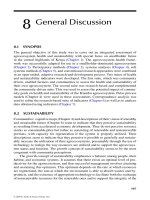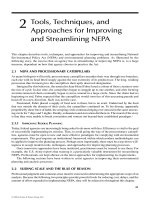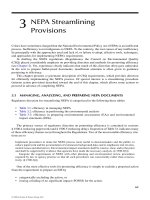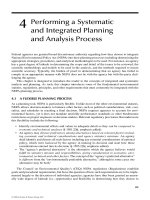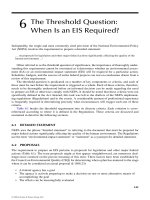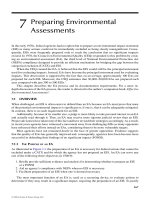NEPA and Environmental Planning : Tools, Techniques, and Approaches for Practitioners - Chapter 11 doc
Bạn đang xem bản rút gọn của tài liệu. Xem và tải ngay bản đầy đủ của tài liệu tại đây (243.84 KB, 19 trang )
279
11
Emergency Planning
for Continuity of
Business Operations
As with the biblical story of Noah’s Ark, ample physical and documentary evidence shows that
throughout the course of human history, different forms of planning have been undertaken to pro-
tect communities from natural disasters. Today, in an increasingly crowded and conicted world, all
organizations, regardless of their size, face risks to their facilities and business operations. While a
small organization may consider itself to be uncomfortably vulnerable to an incident or disaster, a
very large organization might face truly unacceptable risks due to its sheer size and complexity. The
process of assessing and managing the business of continuing operations, also known as business
continuity planning (BCP), has thus become a crucial and necessary reality for ensuring the conti-
nuity and survival of government and business organizations. In an effort to demonstrate this need,
the following discussion outlines the reasons why a business continuity program should be imple-
mented, explains its benets, and describes the processes that support its management throughout
the lifetime of an organization.
In the past, conventional forms of business continuity might have included buying adequate
re insurance, having sufcient re extinguishers on hand, and routinely conducting re drills.
However, in the current environment, several factors have combined to make insurance and passive
deterrents inadequate for dealing with continuity issues. These factors include tougher legislation
in certain areas, increased health and safety concerns, privacy and security issues, rise in insurance
costs and insurance industry mandates for organizations to actively manage their business risks, a
greater likelihood of liability exposure due to legal action, and a high reliance on technology and
sometimes its disparate infrastructure.
Understandably, the importance of business continuity has changed over time. Operational risks
are many and varied, ranging from terrorist incidents to natural disasters and pandemics. Because
of the rapid changes taking place within today’s operating environment, the process of assessing
and managing business risk and operational continuity needs to be both continuous and ongoing.
Many organizations have not yet fully embraced the procedure of developing a business conti-
nuity program. Some organizations still rely solely on the “it won’t happen to me” concept. Evidence
that organizations do not invest sufcient time and resources to BCP preparations is demonstrated
by disaster survival statistics. For instance, res permanently close 44% of affected businesses.
1
Among the 350 businesses affected in the 1993 World Trade Center bombing, 150 failed to survive.
In contrast, the rms affected by the September 11, 2001, attack were back in business within days
of the attack because of their well-developed and tested BCP manuals.
2
Risk should be identied, assessed as to its importance, and remedied by the development of
preventive measures to mitigate its effect. For operations where mitigation efforts would be too
costly or unfeasible, contingency, response, and resumption processes should be established to deal
with any problems that may arise.
Ultimately, the responsibility for introducing a business continuity program lies with the execu-
tive management of the organization. A successful program should be driven down from the top.
This support should include an agreement based on the need to implement such a program, a com-
mitment for the necessary allocation of resources to operate it once approval is obtained, and the
CRC_7559_CH011.indd 279CRC_7559_CH011.indd 279 1/7/2008 9:59:06 PM1/7/2008 9:59:06 PM
© 2008 by Taylor & Francis Group, LLC
280 NEPA and Environmental Planning: Tools, Techniques, and Approaches for Practitioners
development of policies that include directing the top management to become actively involved in
all its aspects. A completed BCP cycle results in a formal printed manual that is available for refer-
ence before, during, and after a disruption has occurred.
11.1 ESSENTIAL CONCEPTS AND BENEFITS
The three terms discussed throughout this chapter are:
BCP: a methodology used to create business continuity processes and plans for how an
organization will assess the risk, mitigate the risk, and resume partially or completely
interrupted critical function(s) within a predetermined time after a disruption or disaster.
Risk: the possibility of the occurrence of an undesirable event.
Essential functions: those services or products that an organization offers.
A business continuity program is dened as
A program supported and funded by executive management to ensure business continuity requirements are
assessed, resources are allocated, mitigation is implemented, and contingency planning, response, recov-
ery, and continuity strategies and procedures are completed and tested. Continuity strategies are a process
of developing advance arrangements and procedures that enable an organization to respond to an event in
such a manner that essential functions continue with planned levels of interruption or essential change.
11.1.1 DEVELOPING THE BUSINESS CONTINUITY PLAN
As with all plans, a business continuity plan includes ve critical elements: its people, processes,
technology, facilities, and infrastructure.
The sustainability aspect of planning is often ignored. Sustainability means simply that the
organization has the resources, motivation, and focus of the management to follow a plan, make
necessary updates to that plan, and practice its use.
Table 11.1 depicts an outline of the stages and processes of the program typically involved.
11.1.2 BUSINESS RISK
Probability and severity are two of the primary factors used to measure and quantify the risks that need
to be managed. Many environmental planners and safety engineers can play an important part in devel-
oping a BCP as they have extensive experience of working with these two concepts. With respect to the
discipline of environmental impact assessment, these concepts were described in detail in Chapter 10.
The use of severity and probability factors provides a practical way to initially assess and pri-
oritize risk. For example, some risks are low in severity and happen frequently, such as minor
workstation failures. Though these risks are very probable, they have a low severity impact. On the
other hand, a more serious event such as the disruption of electrical power from a key supplier has
a higher severity impact that could impede mission-critical business operations, but may also have
a lower probability of occurrence. If some kind of event had occurred in the past, probability and
severity ratings can be more accurately determined.
11.1.3 BENEFITS OF BUSINESS CONTINUITY
Although business continuity applies to all organizations, the benets are not easily quantied.
Some organizations are thus more likely to benet from implementing business continuity pro-
grams, but they are particularly necessary to any organizations with the following characteristics:
Multiple sites
Size that precludes any single individual knowing the details of every risk
•
•
•
•
•
CRC_7559_CH011.indd 280CRC_7559_CH011.indd 280 1/7/2008 9:59:07 PM1/7/2008 9:59:07 PM
© 2008 by Taylor & Francis Group, LLC
Emergency Planning for Continuity of Business Operations 281
Widely diversied business processes
Uses many contractors, suppliers, or business partners who are not under the direct control
of the organization
Generally, the larger or more complex the organization or program, the more it benets from
a formal business continuity program management process. Table 11.2 provides some potential
benets from implementing a proactive program.
•
•
TABLE 11.1
Outline of the Typical Program Stages and Processes
Business Continuity Program Stages Processes Organized by Phases Staff Involvement
Project management • Preproject phase • Program manager
• Start-up phase • Project manager
• Business analyst
Risk management • Inventory phase • Project manager
• Risk assessment phase • Business analyst
• Business impact analysis phase • Inventory compiler
• Database administrator
Mitigation • Mitigation strategy phase • Project manager
• Mitigation planning phase • Business analyst
• Auditor
• Facilitator
• Test process manager
• Testing resources
Contingency • Contingency identication phase • Project manager
• Contingency planning phase • Business analyst
• Facilitator
• Trainer
Response operations • Detection phase • Project manager
• Response phase/crisis management • Business analyst
• Facilitator
• Test process manager
• Testing resources
Business resumption • Recovery phase • Project manager
• Resumption phase • Business analyst
• Personnel training phase • Human resources
• Facilitator
• Test process manager
• Testing resources
TABLE 11.2
Potential Benefits from Implementing a Business Continuity Program
Areas of Impact Benefit of Business Continuity
Health and safety Avoid worker litigation; reduce insurance premiums; ensure public safety
Business interruption Avoid loss of service, business failure, and legal liability (where applicable) for not planning for
such an event; gain operational reliability
Technical Avoid failures of obsolete methods or technologies; avoid a service stoppage
Computer Prevent inability to communicate; avoid lack of access to information
Theft and fraud Prevent loss of money, assets, or intellectual property
CRC_7559_CH011.indd 281CRC_7559_CH011.indd 281 1/7/2008 9:59:07 PM1/7/2008 9:59:07 PM
© 2008 by Taylor & Francis Group, LLC
282 NEPA and Environmental Planning: Tools, Techniques, and Approaches for Practitioners
11.2 FOCUSING ON CONTINUITY OF OPERATIONS
This section focuses on those aspects of business continuity that are concerned with managing risks
related to operations. It ensures that if a serious incident occurs, the organization will continue to
function at a level acceptable to the executive management. With that focus in mind, the question
becomes not one of “Do we need to have a business continuity program?” but rather one of “To what
extent do we need a business continuity program?”
Fundamentally, business continuity is about avoiding loss of business operations. To accom-
plish it, two questions should be answered:
1. What can be done to eliminate a risk before it occurs?
2. If a risk cannot be eliminated, what can be done to minimize the impact after it occurs and
to restore normal operations quickly after an interruption?
Executive management has a responsibility for ensuring that essential functions under its control
are adequately protected. To that end, a cost-effective business continuity strategy should be devel-
oped that is consistent with the organization’s current business strategies. It should focus on risks
related to unplanned interruptions of mission-critical business operations. In the event of a serious
incident, it should also enable essential functions to continue at a predetermined level acceptable to
the management.
In many cases, acceptable protection can be achieved through the proactive formulation of pre-
ventive measures and the strengthening of system and equipment reliability. Mitigation planning is
the process of developing a plan that can either prevent or reduce the likelihood of the occurrence of
a performance failure or that is designed to reduce the impact of a performance failure.
In case a disastrous event occurs, the organization should be prepared to respond and recover
from its impact. Contingency planning is the process of developing a plan to ensure the continued
availability of essential functions, programs, and operations, including all the resources necessary
to operate the organization at a predetermined level, in response to the loss of operational capability.
This process contains procedures for emergency response, backup, postdisaster recovery, reconsti-
tution, and resumption to ensure the continuity of mission-critical business operations.
11.2.1 GETTING STARTED
If the business continuity philosophy is being introduced to an organization for the rst time, it
needs support at the executive management level. Awareness of the need for business continuity
can be raised by
highlighting potential risks to the organization, possibly by drawing comparisons with
other organizations that have suffered serious business disruption and have successfully
weathered the crisis;
illustrating potential impacts to the organization in terms of key performance indicators,
such as customer (interorganizational and outside customers) service levels, costs, staff
turnover, and revenues generated; and
drawing attention to commitments to business continuity made by comparable organiza-
tions, federal, state, and local governments, and industry.
Table 11.3 outlines the essential steps necessary to establish and operate a successful business
continuity program.
11.2.2 PLANNING AND COMMUNICATING THE PROGRAM
An organization-wide business continuity team must be formed to monitor and guide the program.
This team will be responsible for ensuring that any potential problems likely to cause operational
•
•
•
CRC_7559_CH011.indd 282CRC_7559_CH011.indd 282 1/7/2008 9:59:07 PM1/7/2008 9:59:07 PM
© 2008 by Taylor & Francis Group, LLC
Emergency Planning for Continuity of Business Operations 283
failures and revenue reduction are minimized. Organizations should form teams and subteams with
personnel who possess business expertise and skills in such areas as business analysis, environmen-
tal management, communications, legal and contract administration, strategic and tactical plan-
ning, nancial management, project management, information technology, and staff training.
All the employees of the organization should be made aware of the program and provided with
a general introduction to the issues and risks that the organization intends to address. They should
be educated regarding
the business implications of these risks,
who the contact person of the business continuity program is within each organization,
and
the development of a plan to deal with identied risks.
Initial employee communication should include a description of the resources employed to
support the business continuity program and a general outline of how the program is expected
to proceed. Ongoing awareness can be accomplished in many ways such as by including a busi-
ness continuity program column in the organization’s internal newsletter, developing a specialized
business continuity program newsletter, sending out periodic electronic mail messages from the
program’s sponsor, establishing a collaborative business continuity web site, or publishing progress
information on an intranet Web page.
11.2.3 GATHERING INFORMATION
The next step in the business continuity program is to develop a strategy for conducting an
enterprise-wide inventory of
business operations and
essential elements that support the operations.
•
•
•
•
•
TABLE 11.3
Essential Steps Necessary to Establish a Successful Business Continuity Program
1. Form an enterprise-wide business continuity team
2. Form subteams within each organization
3. Communicate the purpose of the business continuity program to employees
4. Create an enterprise-wide inventory of assets and business operations
5. Conduct a high-level risk assessment and report the results
6. Create an enterprise-wide inventory of essential elements that supports business operations
7. Conduct a legal assessment
8. Conduct interviews with key staff from each functional area
9. Collect, store, and analyze the risk data and report the results
10. Plan, develop, and budget for risk prevention measures with mitigation and event-detection processes
11. Test, train, and implement preventive measures and processes
12. Monitor results of preventive measures and revise new processes as necessary
13. Develop contingency plans for risks that cannot be provided with adequate protection
14. Implement event warning, detection, and response processes
15. Develop resumption plans to resume business as usual
16. Train, test, and audit the contingency plans
CRC_7559_CH011.indd 283CRC_7559_CH011.indd 283 1/7/2008 9:59:07 PM1/7/2008 9:59:07 PM
© 2008 by Taylor & Francis Group, LLC
284 NEPA and Environmental Planning: Tools, Techniques, and Approaches for Practitioners
This strategy will establish general objectives concerning the risk exposures on which the orga-
nization intends to focus its efforts. Risks that are inherent to an organization typically originate
from three sources:
Mission, structure, and culture of the organization
Assets and resources either owned by or under the control of the organization
Business partners of the organization
11.2.3.1 Inventory of Essential Elements
For each of these business operations, an inventory of the essential elements that provide direct or
indirect support should be conducted. Generally, an inventory of essential elements in the following
categories is necessary to facilitate an effective risk assessment and business impact analysis (BIA)
(Table 11.4).
An inventory strategy describes the level of inventory detail that should be collected prior to a
risk assessment is being performed. The selected inventory approach should provide data essential
for enabling the more specic identication of potential risks to mission-critical business opera-
tions. Results of this inventory process will help establish
scope of the business continuity program,
overall strategy of the organization’s business continuity program, and
impact on the organization.
Inventory Approaches. Multiple approaches for collecting these inventory data should be examined,
such as
performing only a high-level (macro) inventory;
performing a complete and detail-level (micro) inventory; and
performing a combination of both a high-level and, as needed, a detail-level inventory.
In a situation where limited time and nancial resources are available for commitment to the
business continuity program, an approach for developing an inventory of essential elements, to
perform only a high-level inventory, might be followed by a risk assessment (that will be described
later) based on the summarized inventory data. This approach has the advantage of enabling the
expeditious collection of inventory, which can then be used to begin the risk assessment process.
However, it has the disadvantage of introducing the possibility of overlooking critical operations or
inventory elements, resulting in an incomplete baseline from which the assessment is conducted.
•
•
•
•
•
•
•
•
•
TABLE 11.4
An Inventory of Essential Elements Normally Involves
Seven General Categories
• Business partners, including suppliers, vendors, customers, or other
third-party organizations that regularly provide services or products
• Organizational structure
• Organization-based performance measurements
• Facilities and ofce equipment
• Telecommunication systems
• Computer software and equipment
• Contracts, agreements, insurance, and investments
CRC_7559_CH011.indd 284CRC_7559_CH011.indd 284 1/7/2008 9:59:08 PM1/7/2008 9:59:08 PM
© 2008 by Taylor & Francis Group, LLC
Emergency Planning for Continuity of Business Operations 285
The organization should therefore be diligent in weighing the advantages and disadvantages of each
inventory approach before making its decision.
11.2.4 RISK ASSESSMENT
Once the inventory is complete, a high-level risk assessment is performed. Its purpose is to assess
and prioritize essential functions and their associated risks.
If necessary, the different organizations and each of their respective divisions should complete
their own risk assessment report. These should then be amalgamated to form the enterprise-wide
report. Thereafter, the risk assessment should be updated on an annual or alternate year basis.
A risk assessment typically takes about 1–2 months to complete depending on the size of
the organization. As detailed in Table 11.5, a BCP risk assessment typically involves six discrete
steps.
Throughout the mitigation process, risk management should include risk assessments and busi-
ness impacts for each mitigation strategy. These assessments and impacts should be completed
specically for the particular body of work and should be limited to the scope of the project. Project
risk management should also identify project risks and impacts to the organization.
11.3 BUSINESS IMPACT ANALYSIS
A full-scope BIA should be performed to ensure that both dependencies and interdependencies of
mission-critical business operations are identied and where necessary to employ preventive meas-
ures for mitigating impacts and disruptions.
When performing a BIA, the mission-critical business operations are dened and evaluated
together with their respective essential elements, including dependent and interdependent variables.
The impact analysis can be performed by
1. identifying all business operations, processes, and elements;
2. developing a questionnaire that will help identify, dene, and prioritize the mission- critical
business operations and their respective essential elements;
3. meeting with management to approve the questionnaires;
4. collecting and tabulating questionnaire responses with business and technical personnel;
and
5. producing a prioritized list of essential elements and processes, including their dependen-
cies and interdependencies based upon tabulated questionnaire responses.
An impact analysis is a way to quickly pinpoint those areas that would suffer the greatest
nancial and operational impact in the event of a disruption. Using the severity of impact (of an
TABLE 11.5
Steps Performed during a Typical Risk Assessment
1. Identify, dene, and prioritize the organization’s essential functions (services or products)
2. Identify mission-critical business operations and associated risks
3. Perform a high-level analysis that highlights the severity of impact on the organization, given the loss of a
mission-critical business operation(s)
4. Identify immediately apparent areas of vulnerability, such as the use of single-source suppliers or an outdated
technology infrastructure
5. Prioritize mission-critical business operations
6. Estimate the scope and cost of proceeding with recovery strategies, risk mitigation, and contingency planning
CRC_7559_CH011.indd 285CRC_7559_CH011.indd 285 1/7/2008 9:59:08 PM1/7/2008 9:59:08 PM
© 2008 by Taylor & Francis Group, LLC
286 NEPA and Environmental Planning: Tools, Techniques, and Approaches for Practitioners
operation’s interruption) as the primary rating factor, the management should rate the impact that an
interruption of an operation would have on the critical success factors that enable the success of the
organization. These critical success factors include, but are not limited to, the following:
Safety and security: Would the safety and security of the staff or the physical assets of the
organization be in danger?
Service and/or product fulllment: Would the organization’s ability to generate revenue
and to service its customers be affected?
Legal: Would the organization be in violation of regulatory requirements or contractual
agreements?
External reporting: Would this affect the organization’s ability to generate external reports,
such as nancial statements, tax reports, and so on?
Communications: Would the organization’s ability to communicate by e-mail or telephone
(e.g., electronic data interchange) with its partners be interrupted?
Internal controls: Would the organization’s internal controls, measurements, and reporting
be jeopardized?
It can be seen from the above factors that the management of risk related to essential functions
of the organization becomes the primary focus of the business continuity program. The estab-
lishment of the best and most practical priorities for mitigating risk associated with the essential
functions is the ultimate goal of this process. Accomplishing it means the realization of the most
effective and efcient use of the organization’s resources (staff, time, and money).
11.3.1 REGULATORY, LEGAL, AND CONTRACTUAL REVIEW
In some cases, due to poor planning, the management of an organization can be held personally
liable for its failure or poor performance in carrying out response and recovery operations. For this
reason, a legal assessment of potential liability related to an interruption of mission-critical business
operations is an important part of any business continuity program.
Mandated legal requirements that involve environmental, health, safety, security, and emergency
management are all possible risk areas. These requirements include a detailed review of all con-
tracts, agreements, and documented performance standards, as well as the management’s liability
to service level agreements, contracts, and customer services. The latter requirement encompasses
a review of mandated requirements and of all contractual relationships with third parties, includ-
ing vendors and suppliers. It also includes identifying obligations related to maintenance or other
outsourced services that are being delivered to the organization.
11.3.1.1 Legal Risk Management Strategy
After a risk-reduction mitigation strategy has been prepared to respond to issues discovered during
the legal review, it should be presented to the management for its approval. The aim of the legal risk
management strategy is to provide executive management with sound advice and viable alternatives
as they strive to make responsible business decisions relative to the goals of the business continuity
program.
During the development of the legal risk strategy, special attention should be paid to the fol-
lowing conditions:
Areas where the impact of an interruption to the organization far outweighs the remedies
available
Whether the odd occurrences of such a problem seem likely
Whether recovery from the potential problem is difcult and costly to the organization
Where specic legal mandates are required
•
•
•
•
•
•
•
•
•
•
CRC_7559_CH011.indd 286CRC_7559_CH011.indd 286 1/7/2008 9:59:08 PM1/7/2008 9:59:08 PM
© 2008 by Taylor & Francis Group, LLC
Emergency Planning for Continuity of Business Operations 287
11.3.1.2 Potential Recommendations
To validate the efforts of the organization and to ensure that current activities and plans achieve the
goals of the program, an operational audit of the business continuity program could be one of the
recommendations of the legal risk strategy. Other recommendations could include
1. an outline of the policies and procedures related to business partner management,
2. changes to insurance coverage,
3. operational and procedural changes required to avoid injury and improve safety risks,
4. business continuity program activities required for regulatory compliance,
5. nancial practices required to comply with reporting and disclosure guidelines, and
6. ongoing legal activities required to support the business continuity program.
11.3.2 ASSESSING AND ANALYZING RISKS
As soon as mission-critical business operations have been identied and prioritized, and an inven-
tory of essential elements that support those operations has been collected, the team can proceed
with the next step of the project. At this stage, practical alternatives and guidelines should be dened
that will be used to
gather risk assessment and business impact information;
store the accumulated data in a manner (electronic database) that allows impact analysis
and reporting to be performed; and
assess, quantify, and evaluate risk.
11.3.2.1 Severity and Probability
Developing a model that can be used to assess risk involves the identication of risk measurement
criteria. These criteria consist of factors used to assess the severity and probability of a business
operation or essential element failure. The factors described in Table 11.6 should be considered in
rating the impact severity of a performance failure.
Severity. A precise and easily understood rating scale is needed for assigning severity impact to
the interruption of an operation or an essential element failure; for example,
1 = negligible impact (on the organization or supported operation),
2 = minor impact,
3 = moderate impact,
•
•
•
•
•
•
TABLE 11.6
Factors That Should Be Considered in Rating the Impact Severity of a Performance Failure
• Impairment level of the failure represents the maximum impact resulting from the failure if it is not quickly resolved.
• Time horizon from failure to full impairment, where there could be a time difference between the event of failure and
the full realization of its effects. For example, failure of the general ledger system may ultimately cause severe impair-
ment to an organization’s ability to produce nancial budgets, but the full effect of the loss of that system might take
weeks to be fully realized.
• Failure tolerance is an indication of the maximum length of time that the loss of an essential element or operation can
be reasonably tolerated.
• Mitigation implies reducing the impact (e.g., changing a process, failover, backup, or other strategies). Those that can-
not be mitigated are passed on to contingency planning.
• Contingency planning serves to reduce the ultimate impact experienced by a performance failure involving mitigated
and nonmitigated processes that require human intervention.
CRC_7559_CH011.indd 287CRC_7559_CH011.indd 287 1/7/2008 9:59:08 PM1/7/2008 9:59:08 PM
© 2008 by Taylor & Francis Group, LLC
288 NEPA and Environmental Planning: Tools, Techniques, and Approaches for Practitioners
4 = considerable impact, and
5 = total impairment.
The application of severity ratings to business operations and essential elements provides the
input data needed to conduct a performance failure impact analyses. In many cases, severity impact
ratings may provide enough information for the management to make informed decisions regarding
mitigation and contingency strategies.
The impact of a business operation or the failure of an essential element provides a clear indica-
tion of their importance to the organization. However, the likelihood of a failure actually occurring
should not alter the level of their importance. Therefore, a rating model based upon severity of
impact can provide a straightforward means to establish a prioritized list of business operations and
supporting essential elements.
Probability. In addition, rating the probability of a performance failure helps to highlight poten-
tial failures that pose real or very likely threats to an organization. This separate and distinct rating
measurement helps to focus on appropriate levels of resources on mitigation and contingency plan-
ning efforts. As previously stated, some risks are low in severity but occur quite frequently, while
other risks may be severe but rarely occur. Gathering failure frequency data from staff, vendors, or
suppliers responsible for an essential element can usually provide failure probability estimates for
most items under their scope of responsibility.
11.3.2.2 Developing a BIA Process
After the BIA process has been established, it is used to guide the development and use of an
effective assessment survey tool. A set of comprehensive and business-unit-specic questions is
developed for use during a series of BIA interviews that are conducted with key staff from each
functional area of the organization. These interviews help identify and quantify risks related to the
potential for failure of an essential element, and also
provide insight concerning dependencies that exist between mission-critical business
operations and supporting essential elements, and
provide information on which to base mitigation and contingency-planning activities.
Database. Ideally, a database application should be developed that would serve as the master data
repository for the business continuity program, storing data from the
inventory lists,
risk assessment surveys,
BIA surveys, and
other project-related information.
Database Reports. The database should provide reporting and query capabilities to support risk
assessment and BIA as well as mitigation and contingency-planning efforts. The assessment and
analysis reporting requirements should specify a set of metrics for assessing, selecting, and develop-
ing mitigation and contingency plans.
For example, reports might be structured in the following manner:
1. Identify business operations and assess their severity impact on the critical success fac-
tors of the organization (e.g., safety and security, service or product fulllment, revenue
generation, legal issues, communications, and so on).
2. Identify essential elements (e.g., suppliers, vendors, customers, information technology
systems, documents, data, stafng, equipment, and facilities) and assess their severity
impact in the event of the failure of any of these elements.
•
•
•
•
•
•
•
•
CRC_7559_CH011.indd 288CRC_7559_CH011.indd 288 1/7/2008 9:59:08 PM1/7/2008 9:59:08 PM
© 2008 by Taylor & Francis Group, LLC
Emergency Planning for Continuity of Business Operations 289
The rst report can be used to determine the overall scope of the project and its priorities. The
second report can be applied to each business operation in the order of business operation severity,
to the extent that time, budget, and resource constraints permit. It should be noted here that an issue
raised concerning the above analysis approach is that it could generate a large number of items with
the same severity rating values.
Additional metrics can be used to rene the precision of the BIA and provide executive manage-
ment with more comparative information for decision-making. These may include
the time horizon from the moment of performance failure to full impairment,
the estimated maximum duration that an operation can reasonably tolerate the loss of one
of its essential elements (failure tolerance),
the time required to launch the contingency plans or to implement backup systems, and
the number of operations dependent on or supported by the essential element or
operation.
The risk assessment and impact analysis process should be fully documented and presented to
the management for their approval.
11.4 MITIGATION STRATEGIES
Now that the essential functions, mission-critical business operations, and supporting essential ele-
ments of the organization have been identied and their importance and criticality to its overall suc-
cess have been prioritized, this information can be used in the development of mitigation strategies
and implementation plans.
As previously mentioned, mitigation strategies and implementation planning together is the
process of developing a planned action designed either to
prevent or
reduce the likelihood of the occurrence of a performance failure or to reduce the impact
of a performance failure.
In the context of business continuity and risk management, prevention can be done proactively
to avoid the occurrence of negative impacts on the organization.
11.4.1 EXECUTIVE DECISION-MAKING
Executive management should now make decisions regarding
the allocation of capital for the remainder of the business continuity program,
the priority to be given to the program, and
the impact such priorities will have on other efforts throughout the organization.
It is imperative that sound business rules be established regarding what risks
are to be mitigated,
are considered to be acceptable, and
justify the retirement of a business operation and its supporting essential elements.
Establishing business rules at the outset of this process will help avoid decisions made in an
arbitrary or prejudicial manner. This should also help the executive management to view elements
of the business continuity program as a series of business decisions, allowing them to focus on
appraising the value of managing each identied risk.
•
•
•
•
•
•
•
•
•
•
•
•
CRC_7559_CH011.indd 289CRC_7559_CH011.indd 289 1/7/2008 9:59:08 PM1/7/2008 9:59:08 PM
© 2008 by Taylor & Francis Group, LLC
290 NEPA and Environmental Planning: Tools, Techniques, and Approaches for Practitioners
Cost and benet guidelines and constraints must be clearly dened with stated procedures for
justifying mitigation and contingency planning efforts (such as service levels, product delivery, or
trust impact). If the scope of the project is too broad for the resources allocated, meaningful results
will probably not be possible, resulting in a poor return on investment.
The prevention planning process should examine existing capabilities within the organization.
Existing mitigation and contingency plans should be leveraged to the greatest extent possible in an
effort to avoid the “reinventing the wheel” syndrome. For example, plans may already exist that
contain procedures for dealing with system failures within information technology departments or
divisions of an organization. Plans of this type are generally referred to as disaster recovery, business
resumption, or business continuity plans (in this context a low-level department or division specic).
The need for new processes, awareness, and training should be minimized as much as reason-
ably possible. Such plans should be updated and rolled up to complement the organization’s overall
business continuity plan that in turn affect the enterprise-wide business continuity plan.
11.4.2 MITIGATION IMPLEMENTATION PLAN
As with other plans, a mitigation implementation plan and its subordinate and functionally specic
action plans must
reect the organization’s philosophy,
be dynamic, and
be sustainable.
11.4.2.1 Plan Outline
A plan outline used for the mitigation implementation plan must be established and based upon
the strategy and project scope decisions established when the business rules and guidelines were
adopted at the beginning of the mitigation planning process. An example of an outline for a mitiga-
tion implementation plan that addresses the selected mitigation strategies is depicted in Table 11.7.
11.4.2.2 Mitigation Budget
To avoid any delays in the implementation of the newly developed mitigation action plan, it is neces-
sary at this point to estimate, justify, and formally allocate the budget needed to implement it. At
the minimum, this budget should include the funds required to purchase equipment, compensate
vendors for services, and pay for new facilities or infrastructure, or whatever other expenses that
would be incurred during the effort of executing the plan.
11.4.3 POTENTIAL FIXES
Various methods, or “xes,” that address risk issues can be employed during mitigation planning.
These methods should rst be clearly dened and then assigned individually to each essential ele-
ment being subjected to the planning process. Potential xes include the following methods:
Quick x: Adjustment or correction to an essential element that requires signicantly less
time than other potential remedies.
Partial replacement: Usually applies to a system and involves replacing a nonworking part
or component within a system with a working part or function.
Full redundancy or replacement: Actually two approaches. Full redundancy refers to
prepositioning a working part or component to be used upon failure of the incumbent part
or component. Replacement refers to the total replacement of any failed system or essential
element with a functioning one.
•
•
•
•
•
•
CRC_7559_CH011.indd 290CRC_7559_CH011.indd 290 1/7/2008 9:59:08 PM1/7/2008 9:59:08 PM
© 2008 by Taylor & Francis Group, LLC
Emergency Planning for Continuity of Business Operations 291
Outsourcing: Refers to the utilization of a third-party organization to correct failures of a
given essential element or to provide … (provide what?—assistance, technical expertise,
etc.?).
Hire and train additional staff: A manual alternative to the above methods that can be
used to replace all or part of a failed automated process.
11.5 IMPLEMENTING AND TESTING PREVENTIVE MEASURES
The objective of mitigation action plan testing is to evaluate whether the plans are
capable of providing the desired level of support to the organization’s essential functions
and
whether the plans can be implemented within the estimated period of time.
11.5.1 TESTING AND ACTION PLANS
Test planning and the testing of mitigation action plans either during or after implementation are a
critical part of the business continuity program. Formal acceptance testing guarantees the functional
•
•
•
•
TABLE 11.7
Example of a Mitigation Implementation Plan Outline
Section Title Section Description
Section No. Executive Summary Summary of the Entire Plan
Plan Body
1 Purpose statement Why is the plan being developed?
2 Scope statement What areas are affected by the plan?
3 Responsibilities identication Who is responsible for each part of the plan?
4 Supporting organizations What areas are charged with support development?
5 Coordinating organizations What areas should review the completed plan?
6 Plan review and revision schedule How often and by whom is the plan to be reviewed?
7 Legal review and comment How does the plan affect the enterprise’s legal
relationships?
Plan Support
8 Critical data Data to be used as input to the plan
9 Supporting data Data to be used as support to the plan
Action Plan Guidance
(created for each selected mitigation strategy)
10 Action plan’s required contents Detailed description of the content of individual
action plan, including a description of resources,
staff roles, procedures, and timetables needed for
implementation
11 Administrative and reporting Denes expected level of administrative and
management reporting related to action plan
implementation
12 Associated scal data Contains estimated costs related to action plan
implementation
13 List of action plans A list of all mitigation action plans
14 Reference list, support documents Identies manuals and standard procedures needed to
develop the plan
CRC_7559_CH011.indd 291CRC_7559_CH011.indd 291 1/7/2008 9:59:09 PM1/7/2008 9:59:09 PM
© 2008 by Taylor & Francis Group, LLC
292 NEPA and Environmental Planning: Tools, Techniques, and Approaches for Practitioners
performance of each action plan. The formal test plan for each action plan is unique and specic to
a mission-critical business operation and its related processes or specic projects.
This is not a onetime process. Instead, as organizational and operational changes occur, they
should be documented with complete BCP processes implemented from inventory to resumption. A
comprehensive testing and implementation strategy should be established for this purpose.
In some cases, a specic action plan might require a special testing and implementation process
because of a unique situation. In the case of remedying software application(s) from (for?) a new
project, this might involve unique data interaction requirements or the need to acquire additional
hardware or software. The testing plan and strategy development utilized should be guided by qual-
ity assurance standards in use by the organization.
11.5.2 QUALITY ASSURANCE
Testing and quality assurance issues should be addressed to determine if any changes are necessary
to the organization’s quality assurance practices. Table 11.8 provides questions representative of
quality assurance issues that should rst be answered.
11.5.3 TRAINING
Prior to implementing mitigation action plans, training the staff regarding new processes and pro-
cedures will be required. The amount of training can vary widely depending upon the extent of
operational changes needed to accommodate the action plan. For example, for some employees,
changing old habits can be an extremely difcult task. In a case where a crucial legacy software
application is being replaced after many years of use, a signicant training effort will be needed for
the transition to succeed.
A training “needs assessment” should be conducted to answer questions concerning who needs
training and the specic training that will be required. This assessment should evaluate possible
training alternatives, including
mentoring within the project staff,
using subject matter experts from outside the project to hold classroom training,
individual distribution of a training document to be used by staff, or
formal classroom training presented by the organization’s training department staff.
•
•
•
•
TABLE 11.8
Questions Representative of Quality Assurance Issues
• How or where is the test environment established?
• If a separate test environment does not exist, what are the risks associated with
inadvertent damage to the production environment?
• What are the differences between the test and production environments?
• How are the baseline test standards established?
• What are test results and where will they be saved for future comparisons?
• What organization is responsible for conducting the tests?
• Who will create test documents and test scripts?
• Is there a standard database(s) for system-wide testing?
• What types of tests are required?
• What constitutes acceptable test results?
CRC_7559_CH011.indd 292CRC_7559_CH011.indd 292 1/7/2008 9:59:09 PM1/7/2008 9:59:09 PM
© 2008 by Taylor & Francis Group, LLC
Emergency Planning for Continuity of Business Operations 293
11.6 DEVELOPING CONTINGENCY PLANS
Apart from making the best risk-avoidance efforts, the organization should also be prepared to cope
with various complex “what if” negative impact scenarios. For example, if multiple incidents occur
across organizational and geographical boundaries, accompanied by communication and power
disruptions, the organization needs to have an alternative method to collect, lter, prioritize, and
escalate issues up the management chain, as appropriate.
11.6.1 CONTINGENCY PLANNING GOALS
The ultimate goal of the contingency planning effort is to develop cost-effective contingency plans.
Operational stability and reliability, representing the primary objective of contingency planning,
should be maintained to ensure the survival of essential functions. To that end, contingency plan-
ning objectives include the elements depicted in Table 11.9.
As with mitigation planning, the previously dened essential functions and supporting mission-
critical business operations of the organization are used to drive the development of the com-
plete span of contingency plans. As previously mentioned, contingency planning is the process to
ensure the continued availability of essential functions, programs, and operations, including all the
resources necessary to operate the organization at a level predened by executive management, in
response to the loss of operational capability due to any event.
11.6.2 CONTINGENCY PLANNING FACTORS
Data obtained from the risk assessment and BIA of the probable external or internal impacts that
an organization is exposed to is fundamental to the contingency planning process. The nature of an
event can vary based upon several factors including, but not limited to,
the geographic location of the organization,
the degree of physical accessibility to the organization,
the track record of local utility companies in providing uninterrupted services, and
the history of the area’s susceptibility to technological or natural threats.
11.6.3 POTENTIAL SOLUTIONS
As depicted in Table 11.10, the team should consider a wide range of possible solutions to deal with
the failure of a business operation, process, or an essential element.
•
•
•
•
TABLE 11.9
Contingency Planning Objectives
• Ensure that threats to the safety of the organization’s employees and visitors are minimized
or eliminated
• Provide a sense of security, knowing that mission-critical and other business operations can
continue to function during various situations
• Minimize damage to, or loss of, organizational assets
• Minimize the risk of delay in setting up an alternative processing location for restoration of
mission-critical business operations and their respective essential elements
• Minimize the need for unplanned decision-making during critical situations
• Provide a standard for testing and updating contingency plans
• Ensure the availability of necessary resources, based on the essential function(s), to help the
organization to continue meeting its needs during an interruption
CRC_7559_CH011.indd 293CRC_7559_CH011.indd 293 1/7/2008 9:59:09 PM1/7/2008 9:59:09 PM
© 2008 by Taylor & Francis Group, LLC
294 NEPA and Environmental Planning: Tools, Techniques, and Approaches for Practitioners
11.6.4 TYPES OF CONTINGENCY PLANS
There are different basic types of contingency plans that must be developed by the organization.
These include
incident management plan that encompasses detection criteria and incident and emergency
response processes,
recovery operations that include information technology disaster recovery and infrastruc-
ture recovery processes, and
identication of alternative processes necessary for a mission-critical business operation to
continue functioning until the failure has been resolved.
A department that is responsible for cross-functional support, like facilities, information tech-
nology, or telecommunications, normally develops the failure response plan. The second type of
plan is developed by a department responsible for a specic function, like nance, marketing,
human resources, or engineering, and addresses the need for the mission-critical business operation
to function despite a failure.
11.6.5 STAFFING RESOURCES
Critical stafng resources that are necessary and able to respond in the event of a disaster must be
identied. This can be accomplished by developing an organizational chart showing the command
and control structure of the incident management team (IMT) and the relationship of its members
to the organizational structure of the enterprise. IMT members are identied, and their roles and
responsibilities are dened by establishing standard operating guidelines for each of the team’s
assignments. This ensures that the enterprise has in place a command and control structure that
will be able to respond successfully to an event, minimizing the impact on mission-critical business
operations.
11.6.6 WRITING THE PLAN
When detailed function recovery procedures of the plan are set out in writing, they should be writ-
ten at a level that is clear and detailed enough to allow the plan to be followed just by reading them.
Minimizing the need to make rushed, ad hoc decision-making during a disastrous situation is one
of the major goals of contingency planning.
The plan should encompass all the activities that have to be carried out from the time of the
interruption through the return to normal operations. It is also important to focus on the impact
of the business interruption, as opposed to its cause. Many contingency plans have been written
to address only a specic type of interruption, and consequently fail when a disaster of a different
•
•
•
TABLE 11.10
Possible Solutions for Dealing with a Business Disruption
• Stockpile extra supplies from a key supplier
• Make arrangements for space to store additional supplies or raw materials
• Make arrangement to have supplies delivered by an alternate mode of transportation
• Acquire cellular, radio, and satellite telephones for emergency communications
• Revert to the old manual procedures for a process that has been automated
• Consider using retired employees to provide additional stafng resources
CRC_7559_CH011.indd 294CRC_7559_CH011.indd 294 1/7/2008 9:59:09 PM1/7/2008 9:59:09 PM
© 2008 by Taylor & Francis Group, LLC
Emergency Planning for Continuity of Business Operations 295
nature occurs. In addition, the plan for each function to be recovered and the plan for the enterprise
as a whole should both incorporate the costs of implementation in terms of personnel and nancial
resources.
11.6.7 AUDITING AND TESTING
Prior to nalizing the plan, it is necessary for auditors from the enterprise to become involved in it.
They must conduct a thorough review and audit to determine the tness of the plan for protecting
mission-critical business operations and must attest to the plan’s compliance with laws or regula-
tions regarding contingency planning. Auditors may also be able to expose possible risks from
competitors. For example, in the event of a regional disaster, a direct competitor that already has a
contingency plan in place could conceivably win over additional market share because of its ability
to maintain adequate service levels for its operations throughout the impact period.
It is very important that the plan is thoroughly tested before a disastrous event occurs. This
point cannot be overemphasized. Only by testing the plan, it can be proved that each step has been
well thought out and that nothing has been overlooked. A scenario for testing the plan in the most
realistic manner possible should be developed and carried out on a regular basis. The results of each
test should be measured and documented to determine the plan’s effectiveness since subsequent
evaluations may reveal areas that need to be updated. The installation of a master data repository
that can relate the causes of incidents to their impacts on essential elements and mission-critical
business operations can really boost the effectiveness of the testing process.
11.6.8 MANAGEMENT APPROVAL
Executive management must approve the contingency plan and issue a blanket authorization for
its funding and execution if certain conditions exist. Necessary agreements, letters of intent, and
memos of understanding should be signed and put in place so that the IMT’s response efforts will
not be impeded.
Developing the initial contingency plan is only the beginning of the process. As already recom-
mended, ongoing changes in technology, stafng, and business goals and objectives require that the
plan be regularly reviewed, tested, and updated to remain an effective risk management tool.
11.7 MONITORING RESULTS: A RECAP
Progress tracking of the business continuity program involves providing accurate reports to the
organizational management. This is essential to facilitate decisions regarding any newly imple-
mented mitigation measures. The primary objective of this reporting is to assist with identifying
problem areas that could result from the implementation of new procedures as well as monitoring
their effectiveness.
The business continuity program is an ongoing effort. After procedure tracking processes have
been put in place, regular follow-up review and testing of contingency plans are required to ensure
the readiness of the organization to deal with an unplanned interruption.
Processes for the monitoring and detection of potential threats to the organization should also be
put in place. Criteria and associated metrics, parameters, and alert mechanisms that could be used
as indicators of actual or impending impairments to mission-critical business operations should be
identied. Element monitoring criteria allow oversight personnel to evaluate the operational quality
of an essential element (for example, suppliers, customers, facilities, equipment, data, staff, com-
munications, hardware, and software).
When an event or the threat of an event has been detected, the IMT is notied and it responds
accordingly.
CRC_7559_CH011.indd 295CRC_7559_CH011.indd 295 1/7/2008 9:59:09 PM1/7/2008 9:59:09 PM
© 2008 by Taylor & Francis Group, LLC
296 NEPA and Environmental Planning: Tools, Techniques, and Approaches for Practitioners
11.7.1 RESPONSE AND RESUMPTION RESOURCES
A response and resumption strategy for each service and facility supporting an essential function
can be developed at this time. These resources typically fall into one of the following categories:
1. Facilities—include development of a facility recovery plan, identication of alternate phys-
ical work environments, inventory items, and any other xed assets required to resume
essential functions.
2. Information systems—include duplication of all the necessary computing equipments, the
required operating environment, and the data recovered from off-site storage.
3. Telecommunications—include notication and resumption of voice and data communi-
cations.
4. Operations—include stafng and supplemental stafng if necessary. Direct customer
service functions (internal and external) are normally given a high priority within this
category.
5. Key business partners—include suppliers, vendors, or other third-party organizations pro-
viding crucial products or services to the organization.
11.7.1.1
Critical stafng resources necessary to respond to an event should be identied. This is achieved by
developing an organizational chart showing the command and control structure of the IMT and the
relationship of its members to the organizational structure. Members of the IMT are identied, and
their roles and responsibilities are dened by establishing standard operating guidelines for each of
the team’s assignment. This ensures that the organization has a command and control structure in
place that can successfully respond to an event.
11.7.2 WRITING PROCEDURES
When writing detailed functional processes and procedures, write at a level detailed enough to
allow the process to be followed just by reading them. Minimizing the need for unplanned decision-
making during a situation is one of the goals of the planning process. Processes and tasks should
encompass all necessary activities from the initiation of an interruption through the return to nor-
mal operations.
Many plans have been written to address only a specic type of interruption and consequently
fail when an event of a different nature occurs. Plans should focus on the impact of the business
interruption as opposed to the cause of the interruption. In addition, the plans for each function or
mission-critical business operation to be recovered and the plans for the organization as a whole
should incorporate the costs of implementation in terms of personnel and nancial resources.
11.7.3 AUDITING THE DOCUMENTATION PROCESS
Prior to nalizing the BCP processes and supporting documentation, auditors from the organization
should become involved in conducting a thorough operational audit to determine the plan’s tness
for protecting mission-critical business operations and to certify the plan’s compliance with laws or
regulations regarding business continuity.
The planning processes and tasks should be thoroughly tested before an event occurs. A sce-
nario for testing the plans in as realistic a manner as possible should be developed and carried out
on a regular basis. Results of the tests should be measured and documented to determine the effec-
tiveness of the tasks implemented.
Finally, executive management should approve the plans and issue a blanket authorization for
their funding and execution, provided certain conditions exist. Necessary agreements, letters of
CRC_7559_CH011.indd 296CRC_7559_CH011.indd 296 1/7/2008 9:59:09 PM1/7/2008 9:59:09 PM
© 2008 by Taylor & Francis Group, LLC
Critical Staf fing Resources
Emergency Planning for Continuity of Business Operations 297
intent, and memos of understanding should be signed and put in place so as not to impede the busi-
ness continuity program efforts.
Developing the initial plans is only the beginning of the process. Ongoing changes in technol-
ogy, stafng, and business goals and objectives require that plans be regularly reviewed, tested, and
updated in order to remain effective.
PROBLEM
1. Class project: Assume that there is a large corporate site with 15,000 workers and 60 major
facilities. Develop a strategy for securing corporate business continuity operations against
potential natural disasters. Dene your own assumptions and parameters.
REFERENCES
1. /> 2. />CRC_7559_CH011.indd 297CRC_7559_CH011.indd 297 1/7/2008 9:59:10 PM1/7/2008 9:59:10 PM
© 2008 by Taylor & Francis Group, LLC


